How to modify the maximum number of connections limit in MySQL
1. Prerequisites
Modifying the database is a high-risk behavior. Before making modifications, it is recommended to use the development and test database for demonstration, and Back up relevant data. To prevent database misoperation, data loss, etc.
Prerequisites for modifying MySQL:
1. If you have an account with administrator rights of a Linux user, you need to modify the configuration questionnaire for MySQL installation;
2. The management account of the MySQL database.
3. If there is operation and maintenance, discuss modifications with the operation and maintenance and development personnel. Data is a major matter to prevent data loss and make a backup of the data.
2. Modification steps
1. Use the root user to log in and connect to the database
# mysql -uroot -p
After entering the command, you are prompted to enter the root user password. After entering the password, it is successful. Log in to the database.
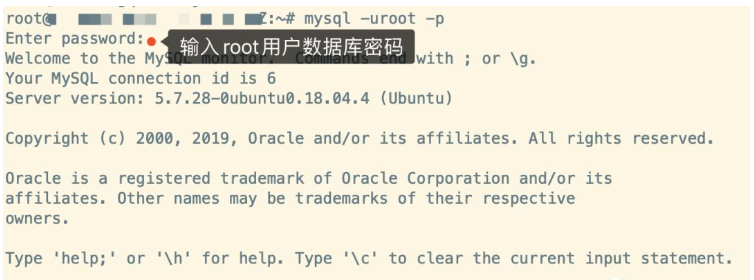
Log in to the MySQL database
2. View the maximum number of connections to the current database
mysql> show variables like 'max_connections';
As shown below, the maximum number of connections to MySQL is only 151 , if you open a few more microservices, you will basically get an exception that there are too many database connections.

Check the maximum number of connections to the database
3. Modify the MySQL configuration file
Find the MySQL configuration file and modify it: /etc/mysql/mysql.conf.d/mysqld.cnf
# view /etc/mysql/mysql.conf.d/mysqld.cnf
Modify the maximum number of connections in the configuration file, max_connections = 2000, save the configuration and exit the editing state .
[mysql] max_connections = 2000
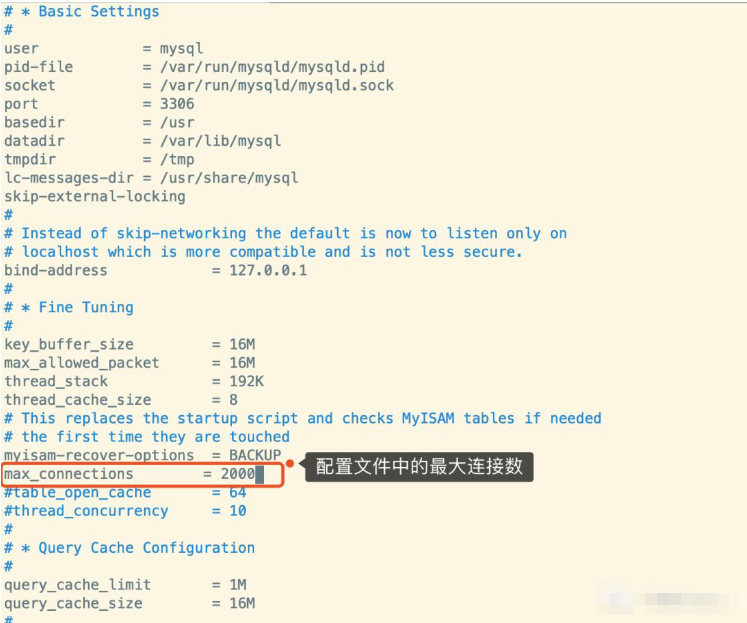
Modify the maximum number of connections in the configuration file
4. Check the system limit limit
Use the command to query the system file limit
# 查询文件限制 $ ulimit -n 1024
If the system file limit you view is 65535, it means that the system has been modified and does not need to be modified.
5. Modify system file limits
5.1. Add the following to the end of /etc/security/limits.conf Two lines of records, save the configuration after editing
# 编辑系统文件配置文件 $ view /etc/security/limits.conf # 在/etc/security/limits.conf最后增加如下两行记录 * hard nofile 65535 * soft nofile 65535
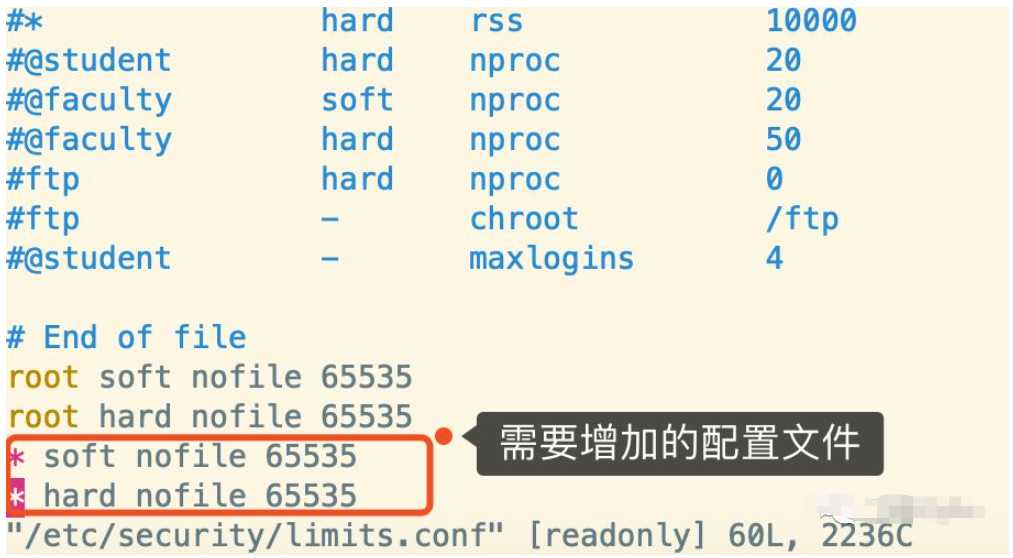
Finally add the following two lines of records
5.2. Edit /etc/pam. d/common-session, add a line session required pam_limits.so
# 编辑/etc/pam.d/common-session, # 加入一行 session required pam_limits.so $ view /etc/pam.d/common-session
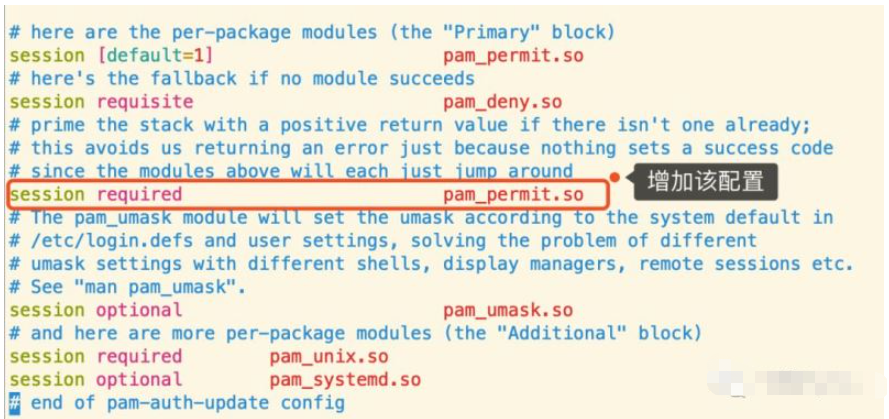
5.3. Edit /etc/profile, add ulimit -SHn 65535, after saving, Execute the scource command to make the configuration effective, and check the system file restrictions again
# 编辑/etc/profile,加入ulimit -SHn 65535 # 编辑完保存 $ view /etc/profile # 执行scource 命令使配置生效,确认修改是否成功 $ source /etc/profile # 再次查看系统limit限制,看配置文件是否生效 $ ulimit -n 65535

mysql.service Start the file
$ systemctl status mysql.service
● mysql.service - MySQL Community Server
Loaded: loaded (/lib/systemd/system/mysql.service; enabled; vendor preset: enabled)
Active: active (running) since Wed 2018-12-19 23:53:28 CST; 16min ago
Process: 25857 ExecStartPost=/usr/share/mysql/mysql-systemd-start post (code=exited, status=0/SUCCESS)
Process: 25843 ExecStartPre=/usr/share/mysql/mysql-systemd-start pre (code=exited, status=0/SUCCESS)
Main PID: 25856 (mysqld)
Tasks: 28 (limit: 4915)
Memory: 185.9M
CPU: 1.577s
CGroup: /system.slice/mysql.service
└─25856 /usr/sbin/mysqld/etc/systemd/system/ multi-user.target.wants, find the file mysql.service;
sudo vim mysql.service, add at the end of [Service]:
LimitNOFILE=65535 LimitNPROC=65535

$ systemctl daemon-reload $ systemctl restart mysql.service
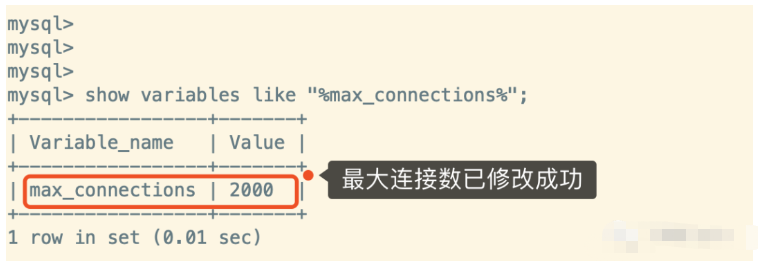
The above is the detailed content of How to modify the maximum number of connections limit in MySQL. For more information, please follow other related articles on the PHP Chinese website!

Hot AI Tools

Undresser.AI Undress
AI-powered app for creating realistic nude photos

AI Clothes Remover
Online AI tool for removing clothes from photos.

Undress AI Tool
Undress images for free

Clothoff.io
AI clothes remover

Video Face Swap
Swap faces in any video effortlessly with our completely free AI face swap tool!

Hot Article

Hot Tools

Notepad++7.3.1
Easy-to-use and free code editor

SublimeText3 Chinese version
Chinese version, very easy to use

Zend Studio 13.0.1
Powerful PHP integrated development environment

Dreamweaver CS6
Visual web development tools

SublimeText3 Mac version
God-level code editing software (SublimeText3)

Hot Topics
 MySQL: An Introduction to the World's Most Popular Database
Apr 12, 2025 am 12:18 AM
MySQL: An Introduction to the World's Most Popular Database
Apr 12, 2025 am 12:18 AM
MySQL is an open source relational database management system, mainly used to store and retrieve data quickly and reliably. Its working principle includes client requests, query resolution, execution of queries and return results. Examples of usage include creating tables, inserting and querying data, and advanced features such as JOIN operations. Common errors involve SQL syntax, data types, and permissions, and optimization suggestions include the use of indexes, optimized queries, and partitioning of tables.
 MySQL's Place: Databases and Programming
Apr 13, 2025 am 12:18 AM
MySQL's Place: Databases and Programming
Apr 13, 2025 am 12:18 AM
MySQL's position in databases and programming is very important. It is an open source relational database management system that is widely used in various application scenarios. 1) MySQL provides efficient data storage, organization and retrieval functions, supporting Web, mobile and enterprise-level systems. 2) It uses a client-server architecture, supports multiple storage engines and index optimization. 3) Basic usages include creating tables and inserting data, and advanced usages involve multi-table JOINs and complex queries. 4) Frequently asked questions such as SQL syntax errors and performance issues can be debugged through the EXPLAIN command and slow query log. 5) Performance optimization methods include rational use of indexes, optimized query and use of caches. Best practices include using transactions and PreparedStatemen
 How to connect to the database of apache
Apr 13, 2025 pm 01:03 PM
How to connect to the database of apache
Apr 13, 2025 pm 01:03 PM
Apache connects to a database requires the following steps: Install the database driver. Configure the web.xml file to create a connection pool. Create a JDBC data source and specify the connection settings. Use the JDBC API to access the database from Java code, including getting connections, creating statements, binding parameters, executing queries or updates, and processing results.
 Why Use MySQL? Benefits and Advantages
Apr 12, 2025 am 12:17 AM
Why Use MySQL? Benefits and Advantages
Apr 12, 2025 am 12:17 AM
MySQL is chosen for its performance, reliability, ease of use, and community support. 1.MySQL provides efficient data storage and retrieval functions, supporting multiple data types and advanced query operations. 2. Adopt client-server architecture and multiple storage engines to support transaction and query optimization. 3. Easy to use, supports a variety of operating systems and programming languages. 4. Have strong community support and provide rich resources and solutions.
 How to start mysql by docker
Apr 15, 2025 pm 12:09 PM
How to start mysql by docker
Apr 15, 2025 pm 12:09 PM
The process of starting MySQL in Docker consists of the following steps: Pull the MySQL image to create and start the container, set the root user password, and map the port verification connection Create the database and the user grants all permissions to the database
 MySQL's Role: Databases in Web Applications
Apr 17, 2025 am 12:23 AM
MySQL's Role: Databases in Web Applications
Apr 17, 2025 am 12:23 AM
The main role of MySQL in web applications is to store and manage data. 1.MySQL efficiently processes user information, product catalogs, transaction records and other data. 2. Through SQL query, developers can extract information from the database to generate dynamic content. 3.MySQL works based on the client-server model to ensure acceptable query speed.
 Laravel Introduction Example
Apr 18, 2025 pm 12:45 PM
Laravel Introduction Example
Apr 18, 2025 pm 12:45 PM
Laravel is a PHP framework for easy building of web applications. It provides a range of powerful features including: Installation: Install the Laravel CLI globally with Composer and create applications in the project directory. Routing: Define the relationship between the URL and the handler in routes/web.php. View: Create a view in resources/views to render the application's interface. Database Integration: Provides out-of-the-box integration with databases such as MySQL and uses migration to create and modify tables. Model and Controller: The model represents the database entity and the controller processes HTTP requests.
 How to install mysql in centos7
Apr 14, 2025 pm 08:30 PM
How to install mysql in centos7
Apr 14, 2025 pm 08:30 PM
The key to installing MySQL elegantly is to add the official MySQL repository. The specific steps are as follows: Download the MySQL official GPG key to prevent phishing attacks. Add MySQL repository file: rpm -Uvh https://dev.mysql.com/get/mysql80-community-release-el7-3.noarch.rpm Update yum repository cache: yum update installation MySQL: yum install mysql-server startup MySQL service: systemctl start mysqld set up booting






